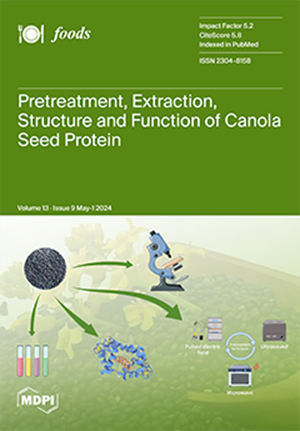Sea Buckthorn Flavonoid Extracted by High Hydrostatic Pressure Inhibited IgE-Stimulated Mast Cell Activation through the Mitogen-Activated Protein Kinase Signaling Pathway
IF 4.7
2区 农林科学
Q1 FOOD SCIENCE & TECHNOLOGY
引用次数: 0
Abstract
Sea buckthorn (Hippophaë rhamnoides L.), as one of the Elaeagnaceae family, has the significant function of anti-tumor, anti-inflammation, anti-oxidation, and other physiological activities. High hydrostatic pressure (HHP) extraction has the advantages of being easy and efficient, while maintaining biological activity. In this study, sea buckthorn flavonoid (SBF) was extracted with HHP and purified sea buckthorn flavonoid (PSBF) was isolated by AB-8 macroporous resin column. HPLC analysis was used to quantified them. In addition, the effect of anti-allergy in RBL-2H3 cells by SBF, PSBF, and their flavonoid compounds was evaluated. The results demonstrate the conditions for obtaining the maximum flavonoid amount of SBF: 415 MPa for 10 min, 72% ethanol concentration, and a liquid to solid ratio of 40 mL/g, which increased the purity from 1.46% to 13.26%. Both SBF and PSBF included rutin, quercitrin, quercetin, isorhamnetin, and kaempferol. In addition, quercitrin, kaempferol, and SBF could regulate Th1/Th2 cytokine balance. Moreover, extracellular Ca2+ influx was reduced by quercitrin and PSBF. Furthermore, rutin, quercetin, iso-rhamnetin, and SBF could also inhibit P-p38 and P-JNK expression, thereby suppressing the phosphorylation of the MAPK signaling pathways. Overall, SBF is effective for relieving food allergy and might be a promising anti-allergic therapeutic agent.通过高静水压提取的沙棘黄酮通过丝裂原活化蛋白激酶信号通路抑制 IgE 刺激的肥大细胞活化
沙棘(Hippophaë rhamnoides L.)是榆叶梅科植物,具有抗肿瘤、抗炎、抗氧化等生理活性。高静压(HHP)萃取具有简便、高效的优点,同时还能保持生物活性。本研究采用高静压萃取沙棘黄酮(SBF),并通过 AB-8 大孔树脂柱分离纯化沙棘黄酮(PSBF)。采用高效液相色谱法对其进行定量分析。此外,还评估了 SBF、PSBF 及其黄酮化合物在 RBL-2H3 细胞中的抗过敏效果。结果表明了获得 SBF 最大黄酮含量的条件:415 兆帕 10 分钟、72% 的乙醇浓度和 40 毫升/克的液固比,从而将纯度从 1.46% 提高到 13.26%。SBF 和 PSBF 中均含有芦丁、槲皮苷、槲皮素、异鼠李素和山奈酚。此外,槲皮素、山柰醇和 SBF 还能调节 Th1/Th2 细胞因子的平衡。此外,槲皮素和 PSBF 还能减少细胞外 Ca2+ 的流入。此外,芦丁、槲皮素、异鼠李素和 SBF 还能抑制 P-p38 和 P-JNK 的表达,从而抑制 MAPK 信号通路的磷酸化。总之,SBF 能有效缓解食物过敏,可能是一种很有前景的抗过敏治疗药物。
本文章由计算机程序翻译,如有差异,请以英文原文为准。
求助全文
约1分钟内获得全文
求助全文
来源期刊

Foods
Immunology and Microbiology-Microbiology
CiteScore
7.40
自引率
15.40%
发文量
3516
审稿时长
15.83 days
期刊介绍:
Foods (ISSN 2304-8158) is an international, peer-reviewed scientific open access journal which provides an advanced forum for studies related to all aspects of food research. It publishes reviews, regular research papers and short communications. Our aim is to encourage scientists, researchers, and other food professionals to publish their experimental and theoretical results in as much detail as possible or share their knowledge with as much readers unlimitedly as possible. There is no restriction on the length of the papers. The full experimental details must be provided so that the results can be reproduced. There are, in addition, unique features of this journal:
manuscripts regarding research proposals and research ideas will be particularly welcomed
electronic files or software regarding the full details of the calculation and experimental procedure, if unable to be published in a normal way, can be deposited as supplementary material
we also accept manuscripts communicating to a broader audience with regard to research projects financed with public funds
文献相关原料
公司名称
产品信息
上海源叶
Isorhamnetin
|
98%
¥138.00~¥19600.00
上海源叶
Kaempferol
|
98%
¥35.00~¥15510.00
上海源叶
Quercitrin
|
98%
¥100.00~¥14549.00
上海源叶
Rutin
|
98%
¥29.00~¥8804.00
上海源叶
上海源叶
槲皮素
¥25.00~¥8412.00
上海源叶
Quercetin
|
98%
¥25.00~¥8412.00
 求助内容:
求助内容: 应助结果提醒方式:
应助结果提醒方式:


